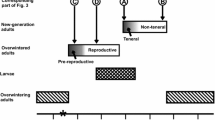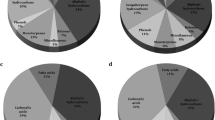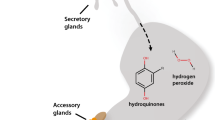Abstract
The defensive secretion of the ground beetle Chlaenius cordicollis is predominantly 3-methylphenol. Adult C. cordicollis were collected in Pennsylvania and Manitoba and induced to discharge defensive secretion in a vial. The headspace was sampled by solid phase microextraction, and samples were analyzed by gas chromatography–mass spectrometry. Five alkylphenolic compounds were detected: all beetles secreted 3-methlyphenol, 2,5-dimethylphenol, and 3-ethylphenol, and most beetles from each locality secreted detectable amounts of 2,3-dimethlyphenol and 3,4-dimethylphenol. In about 80% of beetles, we detected small amounts of the alkoxyphenolic compounds 2-methoxy-4-methylphenol and 2-methoxy-5-methylphenol. Multivariate compositional analysis of relative peak areas of alkylphenolic compounds revealed geographic variation and sexual dimorphism in defensive secretions. Compared with samples from Manitoba, relative peak areas of samples from Pennsylvania were lower for 2,3-dimethylphenol and higher for 3-methylphenol. Sexual dimorphism was detected only in Manitoba where, compared with samples from males, relative peak areas for samples from females were higher for 2,5-dimethylphenol and lower for 3-ethylphenol. This is the first report of geographic variation in defensive secretions of carabid beetles, and it demonstrates the need for knowledge of patterns of variation before characterizing the defensive secretions of a species as a whole.



Similar content being viewed by others
References
Aitchison, J. 1984. The mathematical analysis of geochemical compositions. Math. Geol. 16:531–564.
Attygalle, A. B., Meinwald, J., Liebherr, J. K., and Eisner, T. 1991. Sexual dimorphism in the defensive secretion of a carabid beetle. Experientia 47:269–299.
Balestrazzi, E., Dazzini, M. L. V., De Bernardi, M., Vidari, G., Vita-Finzi, P., and Mellerio, G. 1985. Morphological and chemical studies on the pygidial defense glands of some Carabidae (Coleoptera). Naturwissenschaften 72:482–484.
Bell, R. T. 1960. A revision of the genus Chlaenius Bonelli (Coleoptera, Carabidae) in North America. Misc. Publ. Entomol. Soc. Am. 3:98–166.
Blum, M. S. 1981. Chemical Defenses of Arthropods. Academic Press, New York.
Blum, M. S. 1996. Semiochemical parsimony in the Arthropoda. Annu. Rev. Entomol. 41:353–374.
Bousquet, Y. 1987. Notes about the relationships of the Callistini (= Chlaeniini) (Coleoptera: Carabidae). Coleopts. Bull. 41:165–166.
Bousquet, Y. and Larochelle, A. 1993. Catalogue of the Geadephaga (Coleoptera: Trachypachidae, Rhysodidae, Carabidae including Cicindellini) of America North of Mexico. Mem. Entomol. Soc. Can. 167:1–397.
Chuah, C.-H. 2007. Intraspecific variation in soldier defense secretions of Longipeditermes longipes (Isoptera, Nasutitermitinae). Biochem. Syst. Ecol. 35:600–605.
Daloze, D. and Pasteels, J. M. 1979. Production of cardiac glycosides by chrysomelid beetles and larvae. J. Chem. Ecol. 5:63–77.
Davidson, B. S., Eisner, T., Witz, B., and Meinwald, J. 1989. Defensive secretion of the carabid beetle Pasimachus subsulcatus. J. Chem. Ecol. 15:1689–1697.
Dierckx, F. 1899. Étude comparée des glandes pygidiennes chez les carabides et les dytiscides avec quelques remarques sur le classement des carabides. Cellule 16:63–176.
Eggenberger, F. and Rowell-Rahier, M. 1991. Chemical defense and genetic variation interpopulation study of Oreina gloriosa (Coleoptera: Chrysomelidae). Naturwissenschaften 78:317–320.
Eggenberger, F. and Rowell-Rahier, M. 1992. Genetic component of variation in chemical defense of Oreina gloriosa (Coleoptera: Chrysomelidae). J. Chem. Ecol. 18:1375–1387.
Eggenberger, F. and Rowell-Rahier, M. 1993. Physiological sources of variation in chemical defense of Oreina gloriosa (Coleoptera: Chrysomelidae). J. Chem. Ecol. 19: 395–410.
Eisner, T., Hurst, J. J., and Meinwald, J. 1963. Defense mechanisms of arthropods. XI. The structure, function, and phenolic secretions of the glands of a chordeumoid millipede and a carabid beetle. Psyche 70:94–116.
Forsyth, D. J. 1972. The structure of the pygidial defence glands of Carabidae (Coleoptera). Trans. Zool. Soc. Lond. 32:249–309.
Geiselhardt, S., Jakobschy, D., Ockenfels, P., and Peschke, K. 2008. A sex pheromone in the desert tenebrionid beetle Parastizopus armaticeps. J. Chem. Ecol. 34:1065–1071.
Geiselhardt, S., Schmitt, T., and Peschke, K. 2009. Chemical composition and pheromonal function of the defensive secretions in the subtribe Stizopina (Coleptera, Tenebrionidae, Opatrini). Chemoecology 19:1–6.
Holliday, A. E., Walker, F. M., Brodie, E. D. 3rd., and Formica, V. A. 2009. Differences in defensive volatiles of the forked fungus beetle, Bolitotherus cornutus, living on two species of fungus. J. Chem. Ecol. 35:1302–1308.
Kanehisa, K. and Murase, M. 1977. Comparative study of the pygidial defensive systems of carabid beetles. Appl. Entomol. Zool. 12:225–235.
Kusari, S., Zühlke, S., Borsch, T., and Spiteller, M. 2009. Positive correlations between hypericin and putative precursors detected in the quantitative secondary metabolite spectrum of Hypericum. Phytochemistry 70:1222–1232.
Larochelle, A. and Larivière, M.-C. 2003. A Natural History of the Ground-Beetles (Coleoptera: Carabidae) of America North of Mexico. Pensoft, Sofia.
Lindroth, C. H. 1969. The ground beetles of Canada and Alaska, part 6. Opusc. Entomol. Suppl. 35: 945–1192.
Majka, C. G., Bousquet, Y., and Westby, Y. 2007. The ground beetles (Coleoptera: Carabidae) of the Maritime Provinces of Canada: a review of collecting, new records, and observations on composition, zoogeography, and historical origins. Zootaxa 1590:1–36.
Miller, J. R. and Mumma, R. O. 1974. Seasonal quantification of the defensive titer of Agabus seriatus. (Coleoptera: Dytiscidae). Ann. Entomol. Soc. Am. 67:850–852.
Moore, B. P. 1979. Chemical defense in carabids and its bearing on phylogeny, pp. 193–203 in T. L. Erwin, G. E. Ball, and D. R. Whitehead (eds.). Carabid Beetles: Their Evolution, Natural History and Classification. Junk, The Hague.
Moore, B. P. and Wallbank, B. E. 1968. Chemical composition of the defensive secretion in carabid beetles and its importance as a taxonomic character. Proc. Roy. Entomol. Soc. B 37:62–72.
Pasteels, J. M., Gregoire, J. C., and Rowell-Rahier, M. 1983 The chemical ecology of defense in arthropods. Annu. Rev. Entomol. 28:263–289.
Peschke, K. 1983. Defensive and pheromonal secretion of the tergal gland of Aleochara curtula. II. Release and inhibition of male copulatory behavior. J. Chem. Ecol. 9:13–31.
Roach, B., Dodge, K. R., Aneshansley, D. J., Wiemer, D., Meinwald, J., and Eisner, T. 1979. Chemistry of defensive secretions of Ozaenine and Paussine bombardier beetles (Coleoptera: Carabidae). Coleopts. Bull. 33:17–19.
Schildknecht, H., Winkler, H., and Maschwitz, U. 1968. Vergleichend chemische Untersuchungen der Inhaltsstoffe per Pygidialwehrblasen von Carabiden. Z. Naturforsch. 23 B:637–644.
Sokal. R. R. and Rohlf, F. J. 1995. Biometry. 3rd ed. Freeman, New York.
Ter Braak, C. J. F. and Looman, C. W. N. 1994. Biplots in reduced-rank regression. Biom. J. 36:983–1003.
Ter Braak, C. J. F. and Šmilauer, P. 2002. CANOCO Reference Manual and CanoDraw for Windows User’s Guide: Software for Canonical Commmunity Ordination (version 4.5). Microcomputer Power, Ithaca, New York.
Tschinkel, W. R. 1969. Phenols and quinones from the defensive secretions of the tenebrionid beetle, Zophobas rugipes. J. Insect Physiol. 15:191–200.
Tschinkel, W. R. 1975. A comparative study of the chemical defensive system of tenebrionid beetles: chemistry of the secretions. J. Insect Physiol. 21:753–783.
Valterová, I., Křeček, J., and Vrkoč, J. 1989. Intraspecific variation in the defence secretions of Nausitermes ephratae soldiers and the biological activity of some components. Biochem. Syst. Ecol. 17:327–332.
Will, K. W., Attygalle, A. B., and Herath, K. 2000. New defensive chemical data for ground beetles (Coleoptera: Carabidae): interpretations in a phylogenetic framework. Biol. J. Linn. Soc. 71:459–481.
Will K. W., Gill, A. S., Lee, H., and Attygalle, A. B. 2010. Quantification and evidence for mechanically metered release of pygidial secretions in formic acid-producing carabid beetles. J. Insect Sci. 10:12.
Zhang, Z. Y. and Pawliszyn, J. 1993. Headspace solid-phase microextraction. Anal. Chem. 65:1843–1852.
Acknowledgements
We thank L.J. Donald for technical assistance and Swarthmore College for funding.
Author information
Authors and Affiliations
Corresponding author
Rights and permissions
About this article
Cite this article
Holliday, A.E., Holliday, N.J., Mattingly, T.M. et al. Defensive Secretions of the Carabid Beetle Chlaenius cordicollis: Chemical Components and their Geographic Patterns of Variation. J Chem Ecol 38, 278–286 (2012). https://doi.org/10.1007/s10886-012-0078-x
Received:
Revised:
Accepted:
Published:
Issue Date:
DOI: https://doi.org/10.1007/s10886-012-0078-x




